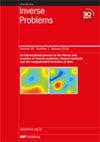Chilled sampling for uncertainty quantification: a motivation from a meteorological inverse problem *
IF 2
2区 数学
Q1 MATHEMATICS, APPLIED
引用次数: 0
Abstract
Atmospheric motion vectors (AMVs) extracted from satellite imagery are the only wind observations with good global coverage. They are important features for feeding numerical weather prediction (NWP) models. Several Bayesian models have been proposed to estimate AMVs. Although critical for correct assimilation into NWP models, very few methods provide a thorough characterization of the estimation errors. The difficulty of estimating errors stems from the specificity of the posterior distribution, which is both very high dimensional, and highly ill-conditioned due to a singular likelihood, which becomes critical in particular in the case of missing data (unobserved pixels). Motivated by this difficult inverse problem, this work studies the evaluation of the (expected) estimation errors using gradient-based Markov chain Monte Carlo (MCMC) algorithms. The main contribution is to propose a general strategy, called here ‘chilling’, which amounts to sampling a local approximation of the posterior distribution in the neighborhood of a point estimate. From a theoretical point of view, we show that under regularity assumptions, the family of chilled posterior distributions converges in distribution as temperature decreases to an optimal Gaussian approximation at a point estimate given by the maximum用于不确定性量化的冷冻采样:气象反问题的动机 *
从卫星图像中提取的大气运动矢量(AMV)是唯一覆盖全球的风观测数据。它们是为数值天气预报(NWP)模型提供资料的重要特征。已经提出了几种贝叶斯模型来估算 AMV。虽然这对正确同化到 NWP 模型至关重要,但很少有方法能对估计误差进行全面描述。估算误差的困难源于后验分布的特殊性,后验分布的维度非常高,而且由于奇异似然的存在,后验分布的条件非常不完善,尤其是在数据缺失(未观测到的像素)的情况下,这一点变得尤为重要。受这一困难逆问题的启发,这项工作研究了使用基于梯度的马尔科夫链蒙特卡罗(MCMC)算法对(预期)估计误差进行评估。其主要贡献在于提出了一种通用策略,在此称为 "冷却",相当于在点估计附近对后验分布进行局部近似采样。从理论角度来看,我们证明了在规则性假设下,冷冻后验分布族的分布会随着温度的降低而收敛到由最大后验值(也称为拉普拉斯近似值)给出的点估计值的最佳高斯近似值。因此,冷冻采样提供了在此类高维非线性环境中通常无法获得的近似值。从经验的角度来看,我们根据一些贝叶斯定量标准对所提出的方法进行了评估。我们对合成和真实气象数据进行了数值模拟。结果表明,所提出的寒冷法不仅在 AMV 点估计及其相关预期误差估计的准确性方面有显著提高,而且还大大加快了 MCMC 算法的收敛速度。
本文章由计算机程序翻译,如有差异,请以英文原文为准。
求助全文
约1分钟内获得全文
求助全文
来源期刊

Inverse Problems
数学-物理:数学物理
CiteScore
4.40
自引率
14.30%
发文量
115
审稿时长
2.3 months
期刊介绍:
An interdisciplinary journal combining mathematical and experimental papers on inverse problems with theoretical, numerical and practical approaches to their solution.
As well as applied mathematicians, physical scientists and engineers, the readership includes those working in geophysics, radar, optics, biology, acoustics, communication theory, signal processing and imaging, among others.
The emphasis is on publishing original contributions to methods of solving mathematical, physical and applied problems. To be publishable in this journal, papers must meet the highest standards of scientific quality, contain significant and original new science and should present substantial advancement in the field. Due to the broad scope of the journal, we require that authors provide sufficient introductory material to appeal to the wide readership and that articles which are not explicitly applied include a discussion of possible applications.
 求助内容:
求助内容: 应助结果提醒方式:
应助结果提醒方式:


